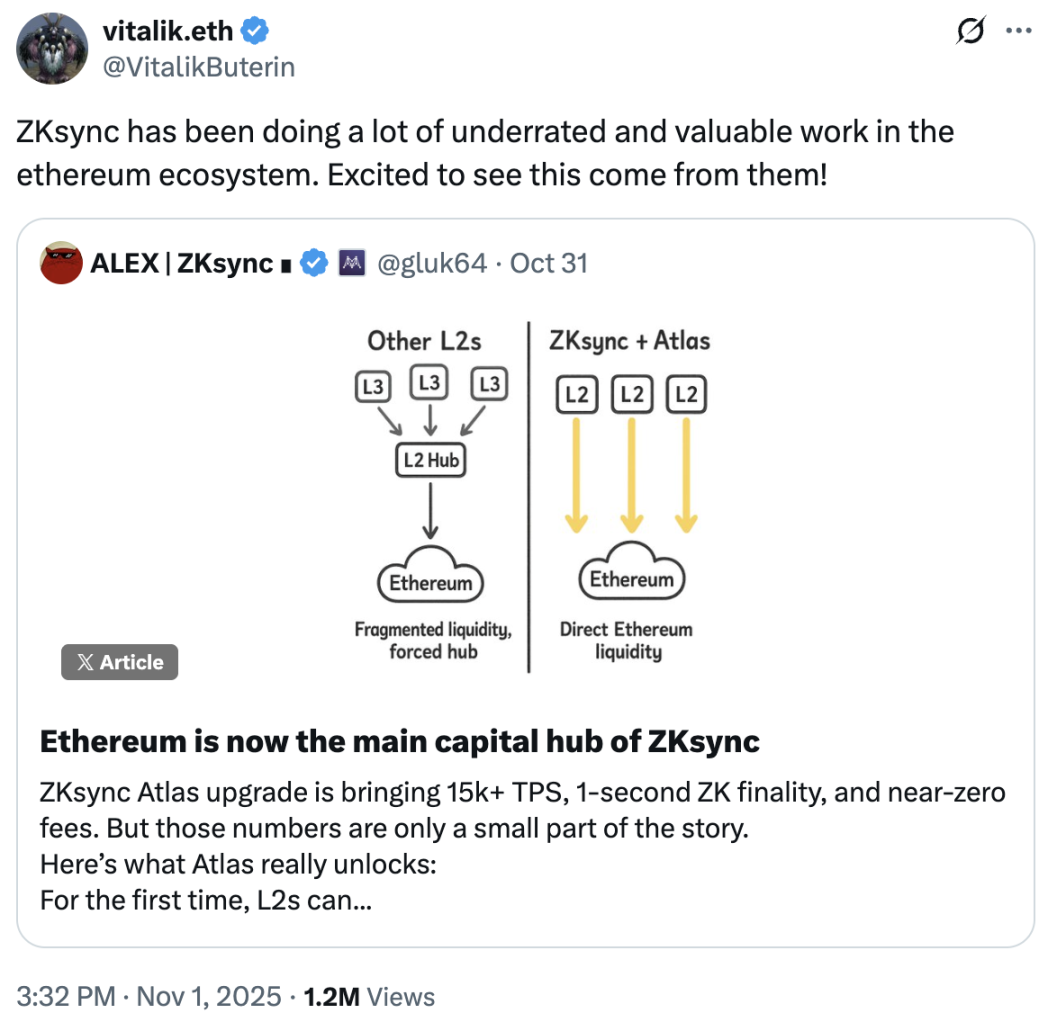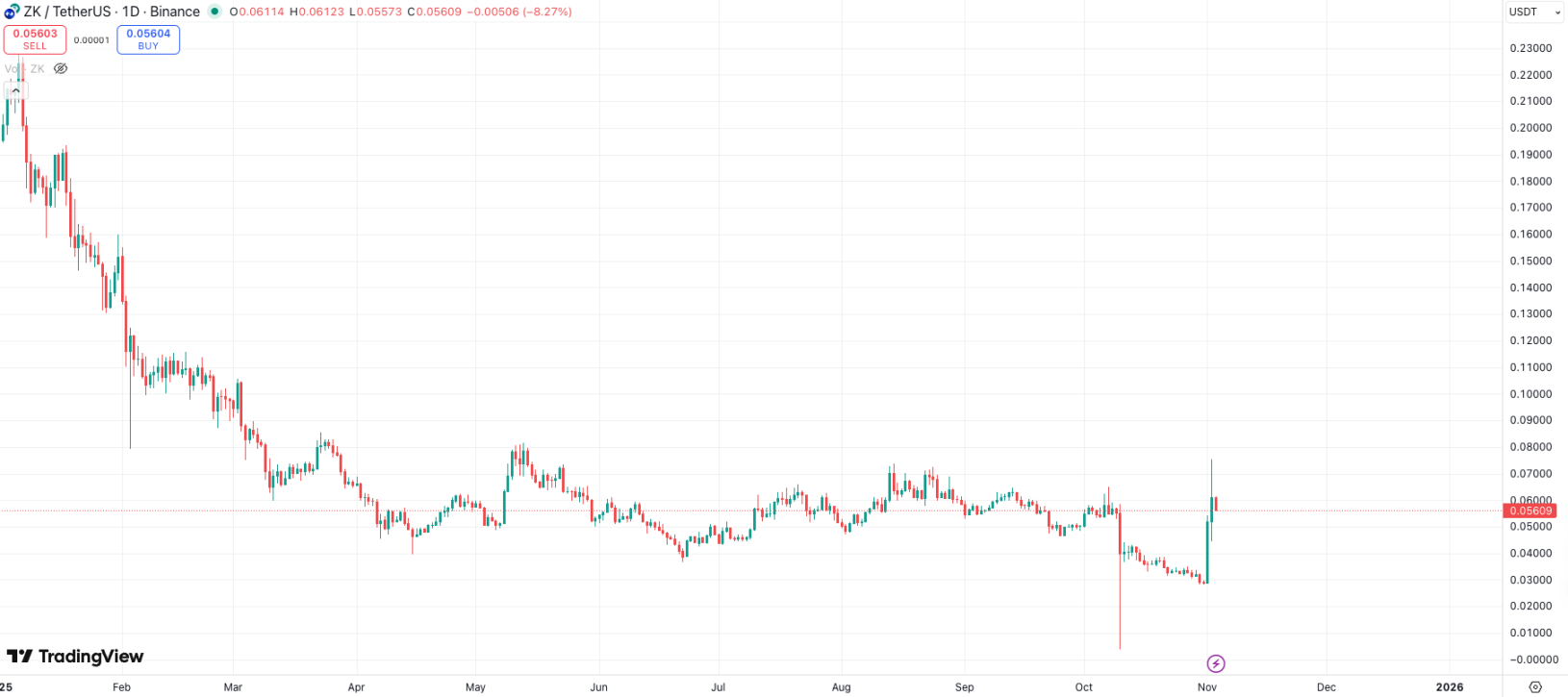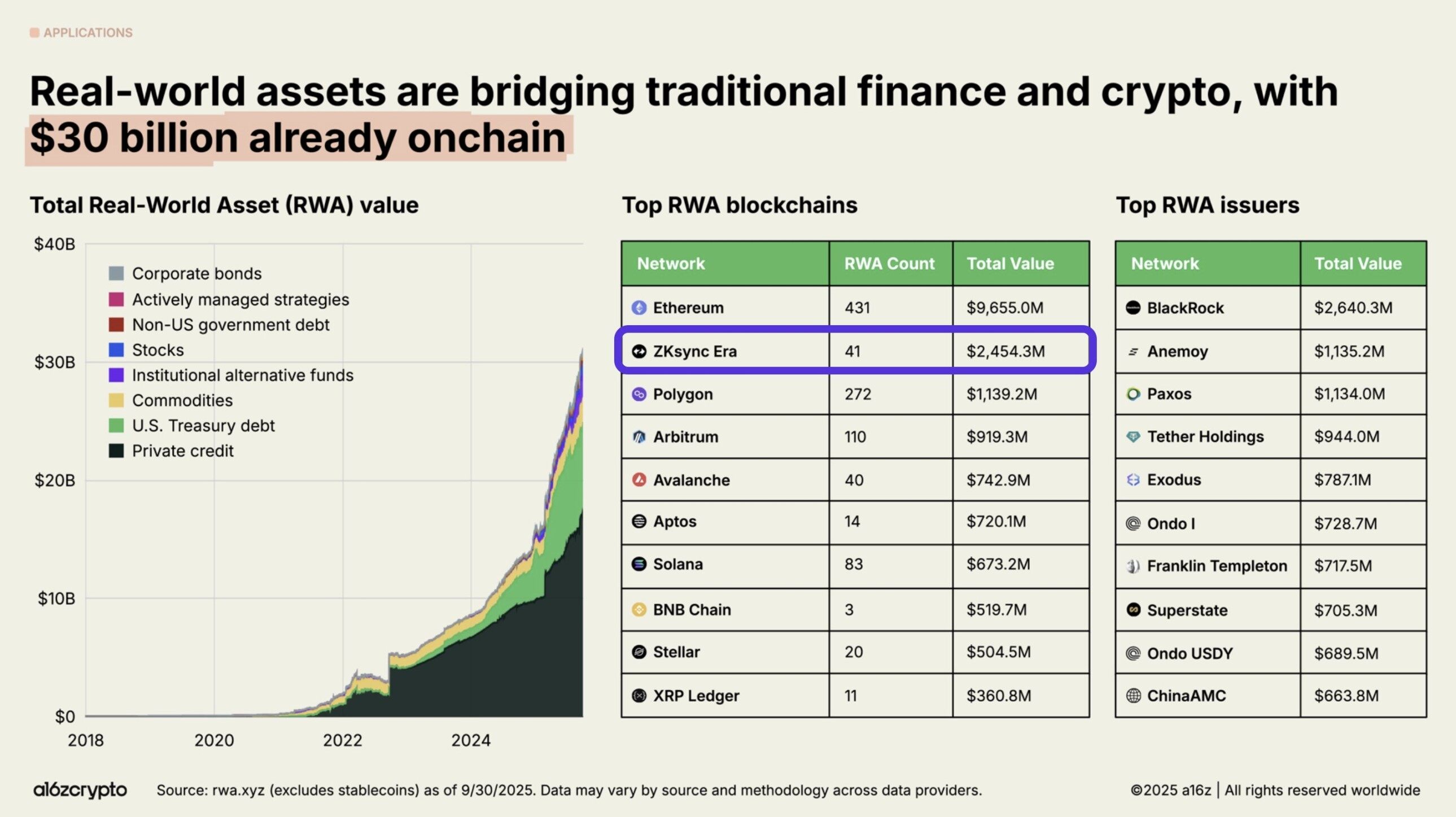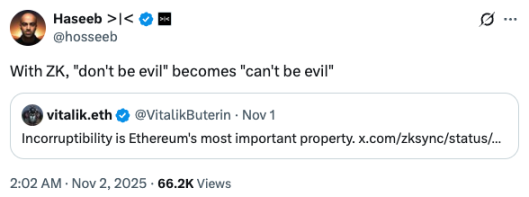Original Author: Eric, Foresight News
On November 1, Vitalik quoted a tweet from the founder of ZKsync regarding the ZKsync Atlas upgrade, praising ZKsync for doing a lot of "underestimated but valuable work for the Ethereum ecosystem."

The market quickly reacted to Vitalik's words, with the price of ZK rising more than 2.5 times over the weekend. Tokens in the ZK ecosystem, including ALT (AltLayer), STRK (Starknet), SCR (Scroll), and MINA (Mina), also saw significant increases.

After learning about the ZKsync Atlas upgrade, we found that what ZKsync has done may indeed be underestimated.
Fast, Small but Expensive ZKP
The Ethereum Foundation has been promoting ZKP (Zero-Knowledge Proof) for a long time, essentially aiming to solve the problems of slow verification speed and large amounts of verification data.
ZKP is essentially a mathematical probability problem. To illustrate its principle with an imperfect example: suppose someone claims to have solved the "Four Color Theorem." How can we determine that this person has indeed solved it without fully disclosing their solution? The solution of zero-knowledge proof is to select some parts of the entire graph and prove that no two adjacent areas have the same color. When the number of selected parts reaches a certain value, it can be proven that the probability of this person having solved the Four Color Theorem has reached 99.99…%. At this point, we have achieved proof of "they indeed solved the Four Color Theorem" without understanding the whole picture.
This is what people often hear about: "proving that something has been done without knowing how it was done" in zero-knowledge proofs. The reason for vigorously promoting ZKP in the Ethereum ecosystem is that the theoretical speed limit of ZKP is much faster than that of transaction-by-transaction proof, and the generated proof itself has a very small data size.
The speed is fast because ZKP does not need to understand the whole picture; it only needs to conduct challenges. For example, to verify an Ethereum block, the current method is for each node to verify whether each transaction's execution address has sufficient balance and other basic issues. However, if only one node verifies each transaction through ZKP and then generates a "proof," other nodes only need to verify that the "proof" itself is reliable. More importantly, the data size of this "proof" is very small, so its transmission and verification speed is extremely fast, and the cost of storing data is lower.
As for why this all-beneficial technology is not widely used, it is because it is too expensive.
Although ZKP does not require reproducing all processes, the challenges themselves consume a lot of computational power. If one were to stack GPUs like in an AI arms race, faster speeds could be achieved, but not everyone can afford such costs. However, if it is possible to reduce the required computing power and the time to generate proofs under low computing power through algorithmic and engineering innovations, achieving a balance between "price increases driven by technological innovation introducing more applications" and "the cost of purchasing GPUs for building nodes" becomes feasible.
Therefore, many ZK concept projects or open-source developers in the Ethereum ecosystem focus on generating ZK proofs at a lower cost and faster speed. Recently, the Brevis team achieved an average proof time of 6.9 seconds for Ethereum blocks using only half the cost of the SP1 Hypercube solution (64 RTX 5090 GPUs), which is why the Ethereum community collectively praised it (99.6% of proof times are less than the current average block time of Ethereum: within 12 seconds).
Although GPU costs still exceed $100,000, at least the proof speed has now dropped to a level comparable to that without ZKP, and the next task for everyone is to reduce costs.
Atlas Upgrade Achieves 1 Second ZK Finality
Perhaps many people do not know that the open-source zkVM ZKsync Airbender launched by ZKsync is the fastest single GPU verification speed zkVM. According to data from Ethproofs, using a single 4090, the average verification time for ZKsync Airbender is 51 seconds, costing less than a cent, both of which are the best results in zkVM.

According to data provided by ZKsync itself, excluding recursion, the average time to verify the Ethereum mainnet using a single H100 and the ZKsync OS storage model is 17 seconds. Even including recursion, the total average time is only about 35 seconds, which ZKsync believes is much better than needing dozens of GPUs to achieve verification within 12 seconds. However, since there is currently only data for two GPUs averaging 22.2 seconds, the actual quality has not yet been concluded.

All of this is not solely due to Airbender; algorithmic and engineering optimizations are just one aspect. The deep integration with the ZKsync tech stack is key to maximizing the effect. More importantly, it indicates that achieving real-time proof of the Ethereum mainnet using a single GPU is possible.
At the end of June, ZKsync launched Airbender, and on the second-to-last day of the National Day holiday, the Atlas upgrade went live. This upgrade, which integrated Airbender, significantly improved ZKsync's throughput, confirmation speed, and cost.
In terms of throughput, ZKsync optimized the sorter through engineering: it maximized the reduction of consumption caused by synchronization through independent asynchronous components; separated the states required by the virtual machine, the states required by the API, and the states needed to generate zero-knowledge proofs or verify zero-knowledge proofs on the L1 layer, thereby reducing unnecessary overhead of components.
Through ZKsync's field tests, the TPS for high-frequency price updates, stablecoin transfers in payment scenarios, and native ETH transfers reached 23k, 15k, and 43k, respectively.
Another significant qualitative change comes from Airbender, which helps ZKsync achieve 1-second block confirmation and a cost of $0.0001 per transaction. Unlike verifying mainnet blocks, ZKsync only verifies the validity of state transitions, so the computational load is much smaller than that of verifying mainnet blocks. Although transactions achieving ZK finality still need to be verified on the mainnet to ultimately achieve L1 finality, having ZK verification indicates the validity of the transaction, making L1 finality more of a procedural guarantee.
In other words, transactions executed on ZKsync only need ZKP verification to be fully confirmed as valid, and with significantly reduced costs, ZKsync has achieved, in their own words, application scenarios that only Airbender can bring:
First, naturally, are applications such as on-chain order books, payment systems, exchanges, and automated market makers. Airbender enables the system to verify and settle at extremely fast speeds, reducing the risk of rollbacks for these applications on-chain.
The second point is something that many current L2s cannot achieve: supporting public and private systems (such as ZKsync's Prividiums) to interoperate without third parties. Prividiums is an infrastructure launched by ZKsync to help enterprises establish private chains. For enterprises, the requirements for blockchain are fast settlement and privacy. Fast settlement goes without saying, and the inherent privacy of ZKP allows enterprise private chains to verify transaction validity without exposing the ledger information of the chain when interoperating with public chains. The combination of the two even meets the compliance requirements for settlement times in on-chain securities and foreign exchange trading.
This may also be the reason why ZKsync has become the second-largest tokenized RWA asset issuance network after Ethereum.

ZKsync proudly states that all of this can only be achieved under the Atlas upgrade: the sorter provides low-latency transaction packaging, Airbender generates proofs within one second, and then the Gateway verifies and coordinates cross-chain messages.
Connecting L1 and L2
As Vitalik retweeted in a tweet, ZKsync founder Alex believes that after the Atlas upgrade, ZKsync has truly connected to the Ethereum mainnet.
Now, the final confirmation time for ZKsync transactions (about 1 second) is shorter than the Ethereum mainnet block time (average 12 seconds), which means that institutional and RWA transactions conducted on ZKsync are essentially consistent with those on the Ethereum mainnet, waiting only for confirmation from the Ethereum mainnet. This means that ZKsync does not need to repeatedly establish liquidity centers on L2; it can directly use the liquidity of the mainnet, as the cross-chain interaction between ZK Rollup and the mainnet does not require a 7-day challenge period like OP Rollup, and the Atlas upgrade further accelerates the speed on this basis.
This has improved the recent discussions in the Ethereum community regarding the fragmentation issue of L2, as L2 and L1 are no longer two separate chains but are connected through fast confirmation and verification, making L2 truly capable of being called a "scaling network" for the first time.
I remember when ZKsync and Scroll first launched on the mainnet, the transaction confirmation speed and gas fees were no different from or even higher than those of the mainnet. This was essentially because there had not yet been systematic optimizations of the algorithms and engineering for ZKP, resulting in slow verification speeds and high costs, which at that time triggered a trust crisis for ZK Rollup. Today, Optimism and Arbitrum are slowly transitioning from OP Rollup to ZK Rollup (or a combination of both), and the further improvements in cost and speed of ZK Rollup like ZKsync, along with Scroll's decentralized ZKP, have transformed from "nonsense" into results worth looking forward to.

From being criticized to becoming a hot topic, ZK has welcomed a dawn. After the multi-signature implementation of sorters and cross-chain bridges is fully decentralized, it may truly achieve what Dragonfly managing partner Hasseb Qureshi said: "can't be evil."
免责声明:本文章仅代表作者个人观点,不代表本平台的立场和观点。本文章仅供信息分享,不构成对任何人的任何投资建议。用户与作者之间的任何争议,与本平台无关。如网页中刊载的文章或图片涉及侵权,请提供相关的权利证明和身份证明发送邮件到support@aicoin.com,本平台相关工作人员将会进行核查。




